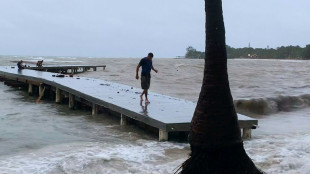
-
 Trump's Republican allies tread lightly on Paris pact at COP29
Trump's Republican allies tread lightly on Paris pact at COP29
-
China's Xi urges APEC unity in face of 'protectionism'

-
 Farmers target PM Starmer in protest against new UK tax rules
Farmers target PM Starmer in protest against new UK tax rules
-
UN climate chief urges G20 to spur tense COP29 negotiations

-
 Philippines warns of 'potentially catastrophic' Super Typhoon Man-yi
Philippines warns of 'potentially catastrophic' Super Typhoon Man-yi
-
Tens of thousands flee as Super Typhoon Man-yi nears Philippines

-
 Gabon votes on new constitution hailed by junta as 'turning point'
Gabon votes on new constitution hailed by junta as 'turning point'
-
Tens of thousands flee as Typhoon Man-yi nears Philippines

-
 Is Argentina's Milei on brink of leaving Paris climate accord?
Is Argentina's Milei on brink of leaving Paris climate accord?
-
Fitch upgrades Argentina debt rating amid economic pain

-
 Trump picks Doug Burgum as energy czar in new administration
Trump picks Doug Burgum as energy czar in new administration
-
At summit under Trump shadow, Xi and Biden signal turbulence ahead

-
 Xi warns against 'protectionism' at APEC summit under Trump cloud
Xi warns against 'protectionism' at APEC summit under Trump cloud
-
Xi, Biden at Asia-Pacific summit under Trump trade war cloud

-
 Leftist voices seek to be heard at Rio's G20 summit
Leftist voices seek to be heard at Rio's G20 summit
-
Boeing strike will hurt Ethiopian Airlines growth: CEO

-
 US retail sales lose steam in October after hurricanes
US retail sales lose steam in October after hurricanes
-
Spate of child poisoning deaths sparks S.Africa xenophobia

-
 Comedian Conan O'Brien to host Oscars
Comedian Conan O'Brien to host Oscars
-
Gore says 'absurd' to hold UN climate talks in petrostates

-
 Global stocks struggle after Fed signals slower rate cuts
Global stocks struggle after Fed signals slower rate cuts
-
China tests building Moon base with lunar soil bricks

-
 Oil execs work COP29 as NGOs slam lobbyist presence
Oil execs work COP29 as NGOs slam lobbyist presence
-
Gore says climate progress 'won't slow much' because of Trump

-
 'Megaquake' warning hits Japan's growth
'Megaquake' warning hits Japan's growth
-
Stiff business: Berlin startup will freeze your corpse for monthly fee

-
 Dominican Juan Luis Guerra triumphs at 25th annual Latin Grammys
Dominican Juan Luis Guerra triumphs at 25th annual Latin Grammys
-
Tropical Storm Sara pounds Honduras with heavy rain

-
 TikTok makes AI driven ad tool available globally
TikTok makes AI driven ad tool available globally
-
Japan growth slows as new PM readies stimulus

-
 China retail sales pick up speed, beat forecasts in October
China retail sales pick up speed, beat forecasts in October
-
Pakistan's policies hazy as it fights smog

-
 Mexico City youth grapple with growing housing crisis
Mexico City youth grapple with growing housing crisis
-
Cracks deepen in Canada's pro-immigration 'consensus'

-
 Japan's Princess Mikasa, great aunt to emperor, dies aged 101
Japan's Princess Mikasa, great aunt to emperor, dies aged 101
-
Venezuela opposition activist dies in custody

-
 Policymakers defend Fed independence amid concerns about Trump era
Policymakers defend Fed independence amid concerns about Trump era
-
Lebanon economic losses top $5 billion in year of clashes: World Bank

-
 Fed Chair calls US the best-performing major economy in the world
Fed Chair calls US the best-performing major economy in the world
-
Brother of late Harrods owner also accused of sexual violence: BBC

-
 New York to revive driver congestion charge plan, drawing Trump ire
New York to revive driver congestion charge plan, drawing Trump ire
-
China's Xi arrives in Peru for APEC summit, Biden meeting

-
 Spain's Vanguardia daily to stop posting on 'disinformation network' X
Spain's Vanguardia daily to stop posting on 'disinformation network' X
-
New York to revive driver congestion charge plan

-
 US stocks wobble as traders weigh future Fed cuts
US stocks wobble as traders weigh future Fed cuts
-
BHP, Vale cleared by Brazil court over 2015 dam disaster

-
 Legal migration to OECD reaches new record in 2023
Legal migration to OECD reaches new record in 2023
-
Central bank independence 'fundamental' for good policy: Fed official

-
 EU fines Meta $840 million for 'abusive' Facebook ad practices
EU fines Meta $840 million for 'abusive' Facebook ad practices
-
Iran tells UN nuclear chief willing to resolve 'ambiguities'


Report details fossil fuel threat to 'Amazon of the seas'
Fossil fuel exploration is threatening an ever-expanding swath of the Coral Triangle, one of the most biodiverse marine areas in the world, a report said Saturday.
Issued to coincide with the UN's COP16 summit on biodiversity in Colombia, the report warned expansion in oil, gas and liquefied natural gas (LNG) in the Indo-Pacific region was putting at risk marine species and the communities that rely on them.
Dubbed the "Amazon of the seas" for its species variety, the Coral Triangle covers over 10 million square kilometers (some four million square miles) in waters of Indonesia, Malaysia, Papua New Guinea, Singapore, the Philippines, Timor-Leste and the Solomon Islands.
It contains three-quarters of the world’s known coral species, said the report by monitoring bodies including the threat-mapping research project Earth Insight, satellite imaging watchdog SkyTruth, and the Center for Energy, Ecology, and Development, a Filipino think tank.
The triangle is a home to six of the world's seven marine turtle species, and acts as a feeding ground for whales and other marine mammals.
More than 120 million people rely on it for subsistence.
Yet, oil and gas concessions and production areas overlap with tens of thousands of square kilometers of marine protected areas, said the report.
It noted more than 100 known offshore oil and gas blocks producing in the region. Another 450 blocks are being explored for future extraction.
"If all blocks were to go into production, about 16 percent of the Coral Triangle would be directly impacted by fossil fuel development," said the report.
It warned fossil fuel expansion will increase tanker traffic and the risk of oil spills.
- Not on track -
Since July 2020, satellites have spotted 793 oil slicks in the Coral Triangle, said the report.
Almost all were created by transiting vessels, some by oil infrastructure.
"Cumulatively, all slicks covered an area over 24,000 km2 –- nearly enough oil to cover the land in the Solomon Islands," said the report.
Its authors called for a moratorium on oil, gas, mining, and other industrial activities in environmentally-sensitive areas within the Coral Triangle.
They also urged "leapfrogging the use of LNG as a transition fuel" as the world moves away from coal and gas, and moving directly to clean energy sources instead.
The report called for the triangle to be designated a "particularly sensitive sea area" in need of special protection from shipping.
The so-called Kunming-Montreal Global Biodiversity Framework approved two years ago by 196 parties to the UN's Convention on Biological Diversity set 23 targets to "halt and reverse" biodiversity loss by 2030.
It includes ensuring that 30 percent of marine and coastal areas are "effectively conserved and managed," and 30 percent are "under effective restoration."
A report by Greenpeace Monday said only 8.4 percent of the global ocean enjoys protection to date.
"At the current rate, we won't hit 30 percent protection at sea until the next century," said Greenpeace policy advisor Megan Randles.
The biodiversity summit meant to measure progress towards achieving the UN goals.
Y.Tengku--CPN
